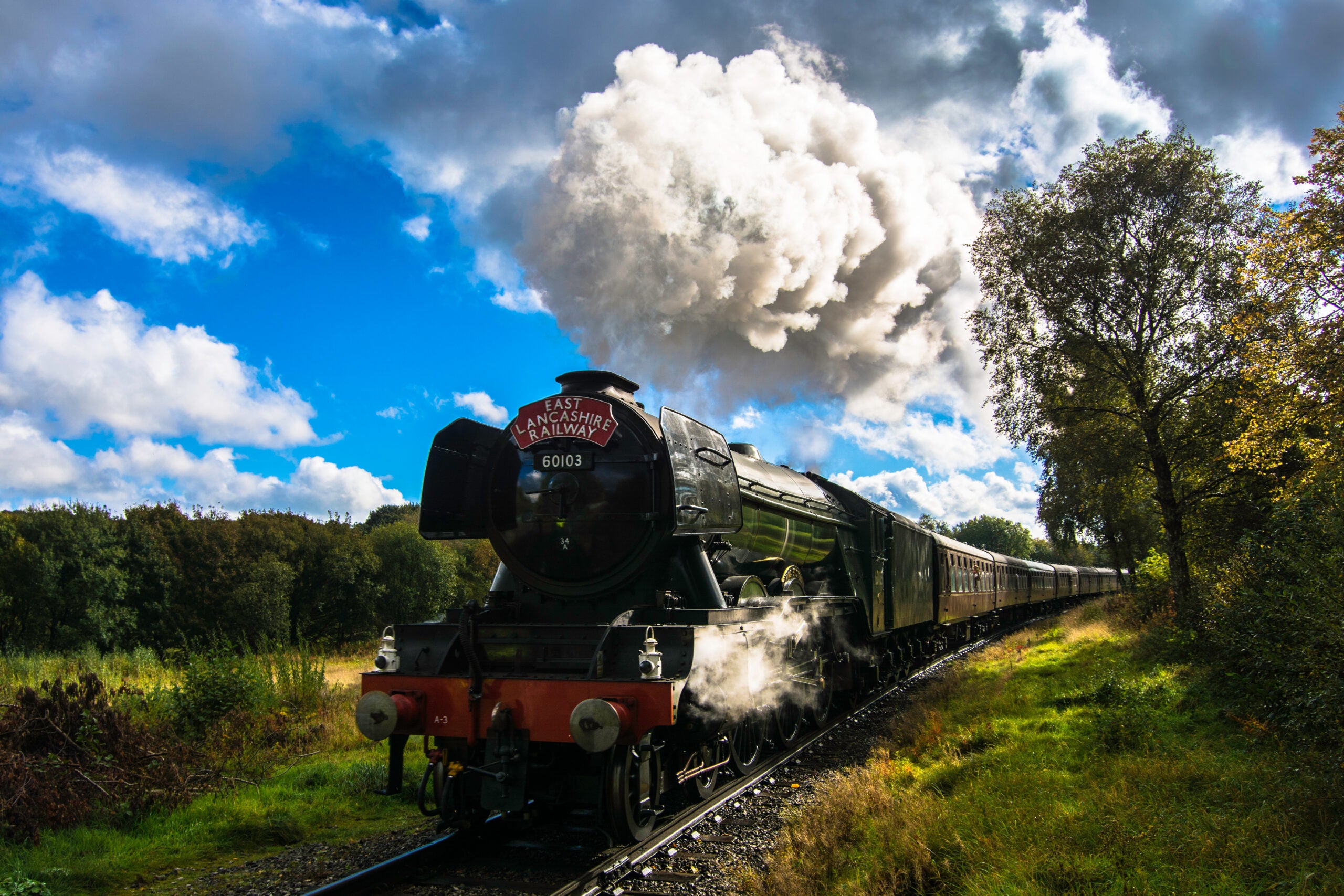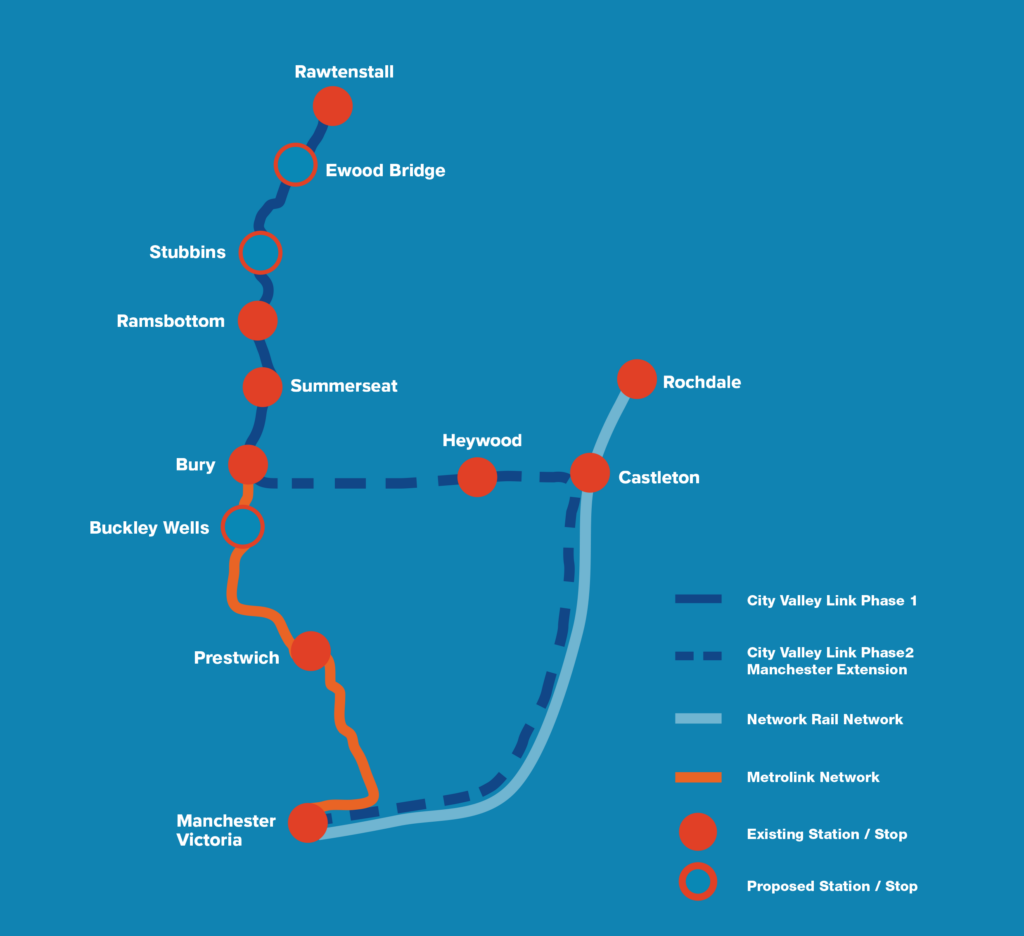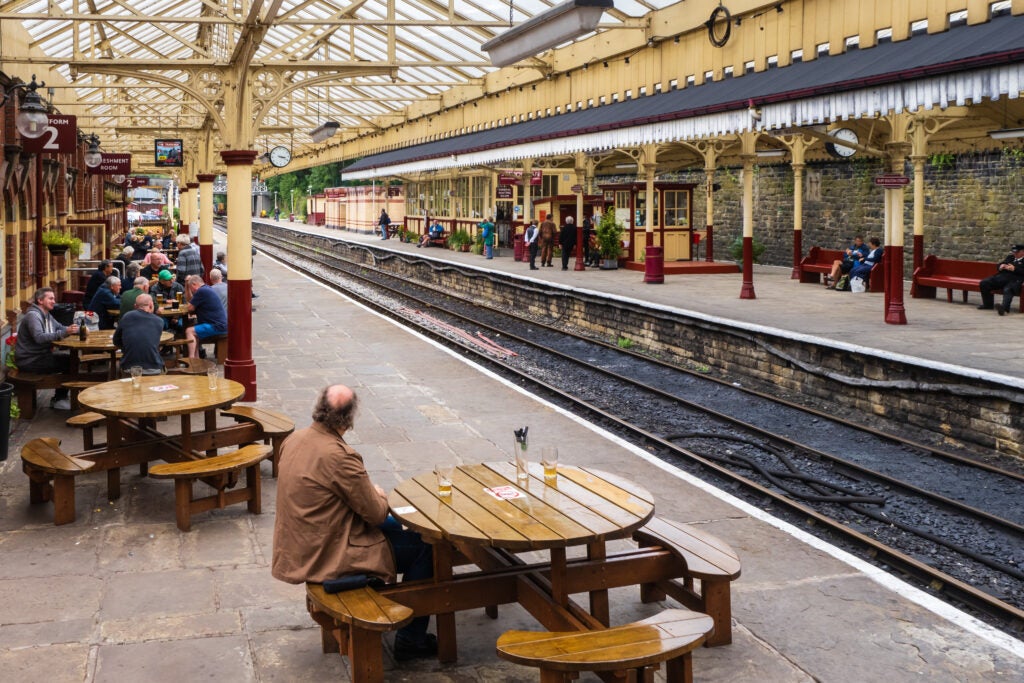
The Lancashire borough of Rossendale lies in the Irwell valley, north of Manchester. It is the only local authority in Lancashire without a rail connection, and as such suffers from high levels of road congestion, especially as a result of traffic to and from Greater Manchester.
Rossendale and wider East Lancashire is a vital commuter base for Manchester, with expanding numbers of residents overloading the M66 as a route into the city centre.
A borough with a population of around 70,000, Rossendale isn’t without any public transport. Bus services connect the area to surrounding towns such as Blackburn, Bolton, Bury, Burnley, and Rochdale, as well as the city of Manchester to the south.
But buses are subject to congestion, and the argument for alternative public transport modes has been growing.
There was once a rail link from Rossendale to Manchester via Bury, but the line was closed – like so many across Britain – as part of the cuts that followed the Beeching Report.
Now, a new business case has been put forward to the Department for Transport for a railway to once again connect Rossendale and Manchester.

US Tariffs are shifting - will you react or anticipate?
Don’t let policy changes catch you off guard. Stay proactive with real-time data and expert analysis.
By GlobalDataWhat is the City Valley Link?
Rossendale Council Leader Alyson Barnes highlights the unenviable status of the borough when it comes to railways: “We are the only borough in Lancashire without a rail link and we cannot afford to miss out any longer.”
But Barnes may not be waiting much longer. Dubbed the City Valley Link, the proposed new link would connect Rawtenstall – the most populous town in the borough – with central Manchester, via Ramsbottom, Bury, and Heywood.
Multinational rail consultant Systra, on behalf of Rossendale Council and Lancashire County Council, has compiled a business case for the new rail link, which has been sent to the Department for Transport for review. The councils hope that the Department for Transport will make a decision on the funding bid by Spring 2023.
The new line would offer an end-to-end journey time of around 44 minutes from Rawtenstall to Manchester, significantly outperforming the current peak time bus/car journey of up to 90 mins. A service of two trains per hour at peak times and one per hour in the off-peak is part of the proposal.

Public opinion seems to be on the same side, A resident and business survey undertaken to gauge views on the project delivered a resounding show of approval with 86% of respondents supportive of the new link.
The new City Valley Link proposal estimates that costs for improvements to the line, as well as station improvements, will total £80m; with an estimated annual operating cost in the region of £3m-£5m.
The proposal includes two new stations, at Stubbins and Ewood Bridge, as well as infrastructure improvements at Rawtenstall station. A connection to Metrolink, Greater Manchester’s tram network, is planned via a pedestrian interchange with at Bury.
Outlined in two phases, the first phase of the City Valley Link would use the existing heritage line between Rawtenstall and create a new rail platform at Bury Market Street station. Phase 2 will use the existing heritage line between Bury (Market Street) via Heywood into Manchester Victoria.
Although primarily using the existing heritage track, a new track passing loop at Summerseat to improve the flow of trains is included in the new proposal.
Respecting railway heritage
A vital part of the brief for the City Valley Link is to ensure that the existing East Lancashire Railway (ELR) heritage services can continue to operate alongside any regular passenger service, and that traditional features including stations and signalling systems would also be maintained.
The ELR is a 12-mile track, running between Heywood and Rawtenstall, with seven stations. The route was reopened in 1991 and has been operated by volunteers ever since. It is an important heritage operation and also boosts the local tourism and leisure economy. The heritage railway hosts around 200,000 visitors annually, making it one of the leading visitor attractions in the Northwest.
“We value the existing ELR heritage line and operation,” the proposal states. It calls the ELR a “significant asset” for East Lancashire and acknowledges it as an integral part of the local visitor economy and an attraction “loved by many”.

A substantial part of the work on the business case was focused on understanding how the proposed service options could be overlaid on the existing ELR operation without diminishing the quality and viability of the operation.
For example, the pedestrian interchange at Bury avoids impact at Buckley Wells, where ELR has plans to develop an engine shed.
Trains will be designed to fit in with the existing heritage character of the railway – and the proposal points to the Vivarail Class 230 as a potential solution, citing its level of customer experience, and high acceleration capability as major factors.
Economic and environmental gains in Rossendale
Rossendale stands to gain economically from the proposed City Valley Link. The proposal estimates that the rail link can contribute to growth of the local economy by at least 5,000 new jobs over the next 25 years.
Improvements in connectivity will also bring the visitor economy within easy reach of the 2.8 million people living in Greater Manchester. The report points to the Whitaker Museum in Rawtenstall and the ELR as leisure attractions that could receive a boost from visitors from Manchester.
The report also mentions potential housing growth in the area and anticipates that the locality will become more attractive to business professionals. According to the proposal, this would generate even higher demand levels for the rail link as the number of residents needing to travel could increase.
Environmental benefits are also plentiful. Currently, nearly 1 in 4 people of working age in Rossendale commute to Manchester each day. The new rail link would remove around half a million car journeys per year, with as many as 1.2 million trips made annually on a new rail link between Rawtenstall and Manchester.
The proposal argues that the City Valley Link would also offer a more financially sustainable future for the ELR as an operator for the line and much-needed upgrades to lineside infrastructure
A new heritage: the ELR strikes back
Under the proposal, ELR would retain control of all operations on its infrastructure. There would also be an opportunity to expand its current role, becoming a professional rail infrastructure and operations organisation, with a continuing volunteer element to operate the heritage train service.
But to do this, ELR would need financial support and the report fails to offer any solutions, merely stating that exploration is needed to find a solution.
On the surface, the new proposal appears to make overtures to protect the ELR, but the heritage railway maintains a firm position.
“While we understand the desire for greater connectivity between Rossendale and Manchester, imposing a commuter service to run on a heritage rail infrastructure is not sustainable economically or operationally,” says ELR Chairman Mike Kelly.
ELR says that this study is the fourth in nine years, many of which have concluded this proposed commuter line isn’t economically viable and would require enormous capital investment, adding that one study also identified that significant annual subsidies would be required to keep the new passenger line in operation.
“A new commuter line cannot coexist with the existing East Lancashire heritage line.“
Kelly says that following an in-depth critical examination of the new proposal, ELR believes that the development would at best threaten the efficient and effective operations of the heritage railway, and at worst force the complete closure of the line. This, he adds, would threaten the growth plans of nearby Bury town centre, the market town of Ramsbottom, and for Rochdale at Heywood and Castleton.
“The ELR is a leading tourist attraction in the region, hosts important educational visits, creates jobs, and contributes £8m annually into local economies,” says Kelly.
“It is our considered view that a new commuter line cannot coexist with the existing East Lancashire heritage line that our volunteers have given so much time and effort to preserve over the last 35 years,” Kelly explains, pointing towards the new proposal’s focus on using the heritage line as the base for the new rail link without acknowledging alternative options.
“Unlike previous studies, it appears the new study has not compared other possible, more cost-effective, deliverable options to improve transport links between Manchester and Rossendale.”



